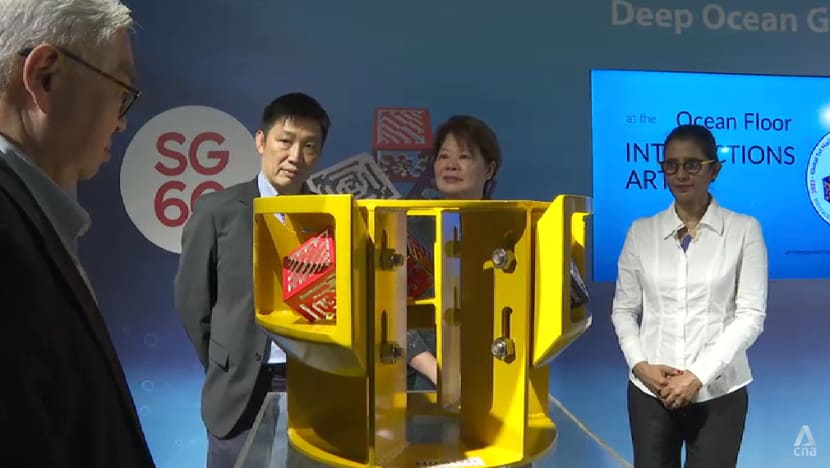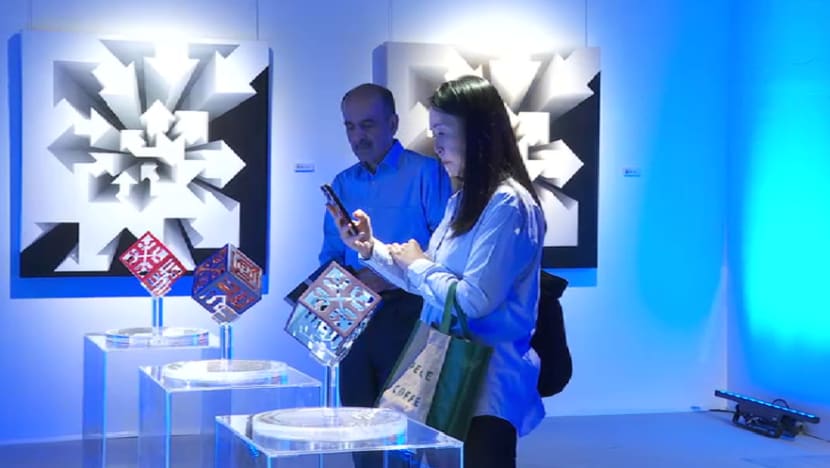Singaporean’s 3D-printed artwork is the world’s deepest ocean art installation
To ensure that artist Lakshmi Mohanbabu’s artwork is sturdy enough to withstand crushing pressure at 7km below the sea, material scientists from NTU invented a new manufacturing process.

Singaporean artist Lakshmi Mohanbabu (R) looks at her one of her art pieces, placed in a holder designed by NuStar Technologies that can bring it to the ocean floor, displayed at the ART NOW gallery.

This audio is generated by an AI tool.
SINGAPORE: Local artist Lakshmi Mohanbabu made headlines three years ago by being the first Singaporean to send artwork up into space.
Recently, she ventured in the other direction – downwards – installing her designs deep in the extreme depths of the earth.
Her artwork features three metal cubes anchored 7km below the sea off the coast of Japan, near the Mariana Trench, the deepest known place in the world.
Ms Lakshmi said the installation serves more than just artistic expression, it is also a collaboration between creative arts and scientific and technological innovation.
“I want people to think of art as not just something that hangs on a wall,” she told CNA’s Singapore Tonight.
“(It’s) about pushing boundaries in exploring how and where art is viewed … in the most uncharted territories on the planet or in outer space … as not separate from science but being part of science.”
The cubes are attached to a seismic sensor on the ocean floor that monitors and issues early warnings for undersea earthquakes and tsunamis. They are also a tribute to honour those impacted by natural disasters.
They were installed on Dec 12 last year by local firm NuStar Technologies, in collaboration with Japan’s Agency for Marine-Earth Science and Technology (JAMSTEC).
NuStar’s managing director Goi Kim Kok said the project demonstrates that “the deep ocean can be a platform for both scientific discovery and cultural expression”.
3D PRINTING A CUBE TO SURVIVE DEEP SEA
The installation is resting in a depth known as the hadal zone – areas deeper than 6km in the ocean.
It is one of the earth’s most unexplored and hostile realms, with crushing pressure, near-freezing temperatures, and complete darkness.
The cubes will have to withstand two main challenges – immense pressure that could crush them, and corrosion which could cause rapid deterioration.
To ensure that her artwork is sturdy enough to endure such harsh conditions, Ms Lakshmi roped in material scientists.
Measuring 10cm on each side, the pieces were crafted from corrosion-resistant stainless steel.

One of the cubes was made using a hybrid manufacturing process invented by researchers at the Nanyang Technological University’s (NTU) Singapore Centre for 3D Printing. The process creates structures that are 70 per cent stronger than bulk steel.
“This was a totally new technology,” said Assistant Professor Lai Chang Quan, who led the team.
“When (Ms Lakshmi) approached us, we were only able to print zipper-sized stuff – really flat and small. (What she wanted) was a massive increase from what (we did),” he recalled.
“In the early days … we were just failing. But she believed in us, and our guys believed in the technology. We went through our own journey of overcoming all these obstacles.”
The team used 80 layers of ultra-thin stainless-steel sheets fused into a 4mm-thick wall, creating a dense structure that is resilient to the extreme pressure and corrosive conditions.
Following the project’s success, Asst Prof Lai recently co-founded a start-up with his students. They plan to expand the potential applications of their technology to the aerospace, maritime, and energy sectors.
ARTWORK EN ROUTE TO THE MOON
The underwater feat follows Ms Lakshmi’s previous endeavour in 2022 that saw two of her artwork reach the International Space Station (ISS).
After orbiting earth onboard the ISS, they are slated to reach their permanent home on the moon later this year, at an extraterrestrial art gallery showcasing 100 pieces of work by international artists.

Her space pieces are similar to the three sent to the ocean floor – also 3D printed metal cubes, albeit much smaller with each side measuring 0.98cm.
But with space, Ms Lakshmi designed her creations with a zero-gravity environment in mind.
They also need to withstand long exposures to extreme temperature differences when they settle on the moon. A lunar day – when the surface of the moon is continuously exposed to sunlight – lasts 14 earth days, and vice versa for lunar nights.
All her cubes feature symbols on their sides that represent art as a universal language and advocates for inclusivity on a global scale.
“I wanted it to be something that bridges and connects people, which is multidisciplinary and multifaceted … that belongs to absolutely everyone, without being owned by any one individual, race or region. So, it's universal,” she said.
Ms Lakshmi added she hopes her projects will inspire fellow Singaporeans to aim for the stars and the deepest oceans.
“Singapore is the first nation to have artworks on the moon and the deep ocean,” she said.
“This milestone is also a testament to Singapore’s pioneering spirit and tenacity as we celebrate SG60 this year.”
















